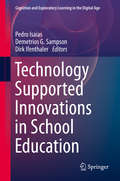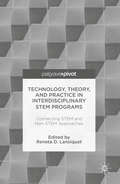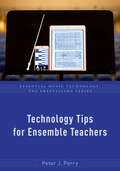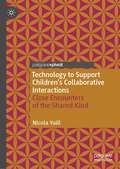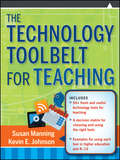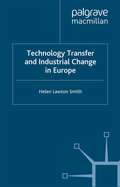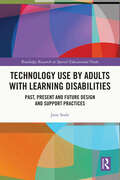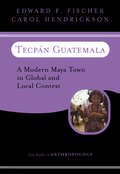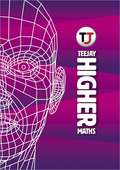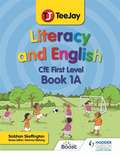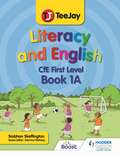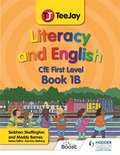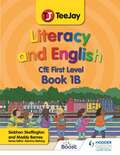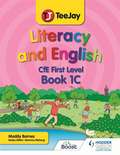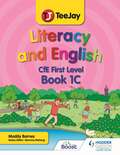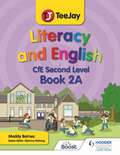- Table View
- List View
Technology Supported Innovations in School Education (Cognition and Exploratory Learning in the Digital Age)
by Pedro Isaias Demetrios G. Sampson Dirk IfenthalerThis volume provides a comprehensive and contemporary depiction of the swift evolution of learning technologies and the innovations that derive from their deployment in school education. It comprises cases studies, research focused on emergent technologies and experiments with existing tools in a wide range of scenarios. The studies included in this volume explore the conceptual and practical aspects of technologies that are used to support learning, with a multidisciplinary approach that encompasses all levels of education. The three sections of this volume emphasise the use of digital technologies from the viewpoint of different fields of expertise, explore multiple educational settings where technology was implemented to support the various stages of the learning process, and underline strategies, tools and technologies that play a crucial role in the professional development of teachers.
Technology Teachers as Researchers: Philosophical and Empirical Technology Education Studies in the Swedish TUFF Research School (INTERNATIONAL TECHNOLOGY EDUCATION SERIES #10)
by Inga-Britt Skogh Marc J. De VriesThis book presents the scientific output of the TUFF research school in Sweden. In this school, a group of active teachers worked together on a series of educational research studies. All of those studies were related to the teaching about technology and engineering. The research program consisted of studies at various angles of view: a philosophical view, a national view, and a classroom practice view. The book is a showcase of how a well-conducted research program for teachers can lead to good contributions to technology education research. A selection of topics: the nature of technological knowledge, mental images of engineers and engineering, the process of choosing for a study in technology, teachers’ beliefs about technology education and assessment. These topics are directly related to major issues in the international technology education research agenda. The studies presented here were the basis of the authors’ Ph.D. theses. The teachers’ chapters are preceded by a description of ideas behind the TUFF research school and the way it was realized.
Technology, Theory, and Practice in Interdisciplinary STEM Programs: Connecting STEM and Non-STEM Approaches
by Reneta D. LansiquotThis book highlights models for promoting interdisciplinary thinking and an appreciation for interdisciplinary understanding among students in STEM-related fields. Students majoring in science, technology, engineering, and mathematics often perceive that courses in their major are not related to the general education liberal arts courses required for their degrees. This separation prevents the transfer of skills between their general education courses and their degree pursuits. The false dichotomy is particularly important because solving the daunting challenges of the twenty-first century—such as drug-resistant bacteria, scarcity of natural resources, and climate change—requires global citizens armed with robust, complex abilities who can integrate interdisciplinary concepts with bold technologies. Contributors to this book explore ways in which this dichotomy can be overcome.
Technology Tips for Ensemble Teachers (Essential Music Technology:The Prestissimo Series)
by Peter J. PerryWritten by veteran music educator Peter J. Perry, Technology Tips for Ensemble Teachers presents a collection of practical tips to help today's school music ensemble director incorporate and implement technology in all aspects of large ensemble instruction. This go-to guide offers specific methods for the use of technology in ensemble instruction, identifies applicable technologies, and details proven ways to successfully use those technologies in instruction. Tips throughout the book vary in type and complexity, allowing directors of all technical abilities to use the book effectively to meet the unique needs of their ensembles and students. They also offer content-specific examples for technologies in band, orchestra, jazz ensemble, and chorus instruction, as well as emerging ensemble settings such as percussion ensembles, guitar ensembles, rock bands, a capella groups, and iPad ensembles. With a special focus on current technologies including mobile devices, Technology Tips for Ensemble Teachers is a timely and useful resource for directors as students and classrooms become ever more technology-oriented.
Technology to Support Children's Collaborative Interactions: Close Encounters of the Shared Kind
by Nicola YuillThis book explores how technology can foster interaction between children and their peers, teachers and other adults. It presents the Co-EnACT framework to explain how technology can support children to collaborate, so helping them to learn and engage enjoyably with the world, in both work and play. The focus is on children, rather than young people, but the principles of supporting interaction apply throughout all life stages. Chapters on classrooms and on autism explain principles behind using technology in ways that support, rather than obstruct, social interaction in diverse populations. Collaborative interaction involves both verbal and non-verbal behaviour and this book presents evidence from closely analysing children’s behaviour in natural settings. Examples from cutting-edge technology illustrate principles applicable to more widely-available technology. The book will be of interest to psychologists, educators, researchers in Human–Computer Interaction (HCI), particularly those designing with children in mind, and practitioners working with children who want to deepen their understanding of using technology for collaboration.
The Technology Toolbelt for Teaching
by Susan Manning Kevin E. JohnsonInstructors are under pressure to integrate technology into their traditional or online instruction, but often they aren't sure what to do or why they should do it. The Technology Toolbelt for Teaching offers instructors a down-to-earth guide to common technologies, explains the pedagogical purposes they serve, and shows how they can be used effectively in online or face-to-face classrooms. Designed to be easy to use, the book includes a decision-making matrix for each technology tool: a series of questions that teachers can use to decide whether these tools support their teaching goals. This comprehensive resource contains an array of useful tools that address problems of organization such as a time management calendar, aids for scheduling meetings, and mind-mapping or graphic organizers. The authors also include a variety of online tools for communication and collaboration, and tools to present content, help establish presence, and assess learning. Praise for The Technology Toolbelt for Teaching "Feeling overwhelmed and even afraid of integrating technology into your course? Fear no more! Susan Manning and Kevin Johnson have provided the ultimate guide that explains not only the various technology tools that can support faculty work and enhance coursework but also provides sound advice to help faculty choose the right tool for the job. This is a must-read for all faculty regardless of their experience with technology."—Rena M. Palloff and Keith Pratt, managing partners, Crossroads Consulting Group, and authors, Building Online Learning Communities and Collaborating Online "The Technology Toolbelt for Teaching delivers exactly what it promises: a concrete overview of a wide variety of tools, complete with examples specific to practitioners in both K–12 and higher education. Authors Susan Manning and Kevin Johnson provide practical applications rather than philosophy, and solutions rather than platitudes. This is a must for any teacher working with—or wanting to start working with—technology."—Jane Bozarth, author, Social Media for Trainers; eLearning coordinator, State of North Carolina "Creating compelling learning experiences for students is fraught with decision points. Add one or more technology options to the equation, and the number of directions to take learners seems to grow limitlessly, and can either paralyze the instructional design process or cause us to take on too much. Enter The Technology Toolbelt for Teaching. Manning and Johnson's handy guide – and the decision-making matrix that frames each of the tools it demystifies – is an essential resource for choosing paths wisely."—Jonathan Finkelstein, author, Learning in Real Time; founder and executive producer, LearningTimes Includes 50+ fresh and useful technology tools for teaching A decision matrix for choosing and using the right tools Examples for using each tool in higher education and K–12
The Technology Toolbelt for Teaching
by Susan Manning Kevin E. JohnsonInstructors are under pressure to integrate technology into their traditional or online instruction, but often they aren't sure what to do or why they should do it. The Technology Toolbelt for Teaching offers instructors a down-to-earth guide to common technologies, explains the pedagogical purposes they serve, and shows how they can be used effectively in online or face-to-face classrooms. Designed to be easy to use, the book includes a decision-making matrix for each technology tool: a series of questions that teachers can use to decide whether these tools support their teaching goals. This comprehensive resource contains an array of useful tools that address problems of organization such as a time management calendar, aids for scheduling meetings, and mind-mapping or graphic organizers. The authors also include a variety of online tools for communication and collaboration, and tools to present content, help establish presence, and assess learning. Praise for The Technology Toolbelt for Teaching "Feeling overwhelmed and even afraid of integrating technology into your course? Fear no more! Susan Manning and Kevin Johnson have provided the ultimate guide that explains not only the various technology tools that can support faculty work and enhance coursework but also provides sound advice to help faculty choose the right tool for the job. This is a must-read for all faculty regardless of their experience with technology."—Rena M. Palloff and Keith Pratt, managing partners, Crossroads Consulting Group, and authors, Building Online Learning Communities and Collaborating Online "The Technology Toolbelt for Teaching delivers exactly what it promises: a concrete overview of a wide variety of tools, complete with examples specific to practitioners in both K–12 and higher education. Authors Susan Manning and Kevin Johnson provide practical applications rather than philosophy, and solutions rather than platitudes. This is a must for any teacher working with—or wanting to start working with—technology."—Jane Bozarth, author, Social Media for Trainers; eLearning coordinator, State of North Carolina "Creating compelling learning experiences for students is fraught with decision points. Add one or more technology options to the equation, and the number of directions to take learners seems to grow limitlessly, and can either paralyze the instructional design process or cause us to take on too much. Enter The Technology Toolbelt for Teaching. Manning and Johnson's handy guide – and the decision-making matrix that frames each of the tools it demystifies – is an essential resource for choosing paths wisely."—Jonathan Finkelstein, author, Learning in Real Time; founder and executive producer, LearningTimes Includes 50+ fresh and useful technology tools for teaching A decision matrix for choosing and using the right tools Examples for using each tool in higher education and K–12
Technology Transfer and Industrial Change in Europe
by H. Smith E. SwyngedouwThis book critically examines the phenomenon and the consequences of the increasing inter-dependence between industry, universities and national laboratories. It explores the contrasts and similarities between the patterns of formal and informal links in a technologically dynamic industry (electronic components) with those in a traditional industry (flow measurement) in the UK, France and Belgium. It uses evidence from interviews with firms, academics and industry organisations in the three countries to identify the major factors which regulate links.
Technology Transfer Via University-Industry Relations: The Case of the Foreign High Technology Electronic Industry in Mexico's Silicon Valley (RoutledgeFalmer Studies in Higher Education)
by Maria Isabel VargasThis book examines the technology that is transferred in Mexico's Silicon Valley and the role that institutions of higher education and foreign electronics corporations play in the process. Riveria Vargas delineates that technology transfer is occurring, describes it nature, the channels of transfer, and its level by focusing on the informal mechanisms of technology transfer. Among the significant findings are that there has been very limited real technology transferred and that most of it is concentrated in operative-level capabilities. This study reveals that the lack of absorptive scientific and technological capacity, as a factor often cited to explain transfer failure, did not apply in the case of the region examined. In point of fact, the scientific and technological capacities exhibited in the region are superior to those in the Silicon Valley of the East in Malaysia during the 1970's and 1980's , where some studies reported more significant technology transfer. What then are the factors hindering technology transfer in some regions or promoting it in others? This book explores some the factors in play.
Technology Transfer Via University-Industry Relations: The Case of the Foreign High Technology Electronic Industry in Mexico's Silicon Valley (RoutledgeFalmer Studies in Higher Education)
by Maria Isabel VargasThis book examines the technology that is transferred in Mexico's Silicon Valley and the role that institutions of higher education and foreign electronics corporations play in the process. Riveria Vargas delineates that technology transfer is occurring, describes it nature, the channels of transfer, and its level by focusing on the informal mechanisms of technology transfer. Among the significant findings are that there has been very limited real technology transferred and that most of it is concentrated in operative-level capabilities. This study reveals that the lack of absorptive scientific and technological capacity, as a factor often cited to explain transfer failure, did not apply in the case of the region examined. In point of fact, the scientific and technological capacities exhibited in the region are superior to those in the Silicon Valley of the East in Malaysia during the 1970's and 1980's , where some studies reported more significant technology transfer. What then are the factors hindering technology transfer in some regions or promoting it in others? This book explores some the factors in play.
Technology Use by Adults with Learning Disabilities: Past, Present and Future Design and Support Practices (Routledge Research in Special Educational Needs)
by Jane SealeThis book examines the role that technologies play in the lives of adults with learning disabilities. It analyses how design and support practices can be used to support access to technology in ways that can enhance opportunities and life experiences. Drawing on international literature and the author’s own research, the book considers what we know about past and present practices of supporting adults with learning disabilities to use technologies. It outlines how support practices can offer opportunities to overcome digital inequalities, offering a framework of core beliefs and knowledge that can inform future initiatives. The book has a particular focus on technologies, policies, practitioner communities and the characteristics of support practice. It also highlights the potential of people with learning disabilities, the potential of technology and the potential of the environment to support technology use. This important book will be highly relevant reading for academics, researchers and post-graduate students in the field of special educational needs and disabilities, digital education and learning technologies, inclusive education and social work.
Technology Use by Adults with Learning Disabilities: Past, Present and Future Design and Support Practices (Routledge Research in Special Educational Needs)
by Jane SealeThis book examines the role that technologies play in the lives of adults with learning disabilities. It analyses how design and support practices can be used to support access to technology in ways that can enhance opportunities and life experiences. Drawing on international literature and the author’s own research, the book considers what we know about past and present practices of supporting adults with learning disabilities to use technologies. It outlines how support practices can offer opportunities to overcome digital inequalities, offering a framework of core beliefs and knowledge that can inform future initiatives. The book has a particular focus on technologies, policies, practitioner communities and the characteristics of support practice. It also highlights the potential of people with learning disabilities, the potential of technology and the potential of the environment to support technology use. This important book will be highly relevant reading for academics, researchers and post-graduate students in the field of special educational needs and disabilities, digital education and learning technologies, inclusive education and social work.
Tecpan Guatemala: A Modern Maya Town In Global And Local Context (Case Studies in Anthropology)
by Edward F Fischer Carol HendricksonWhat does it mean to be Maya in the modern world? Focusing on a Guatemalan town, this case study explores the cultural, political, and economic changes of this society over time. . This case study of a highland Guatemala town examines what it means to be Maya in a rapidly changing and globalized world. In providing an historical synopsis of the Kaqchikel Maya from preColumbian through Colonial times to the present day, this volume focuses on the use of language, dress, and crafts as emblems of ethnicity, nationality, and political allegiance. Tecpn considers the dynamics of ethnic boundaries in light of the use of the Kaqchikel language versus Spanish, the growing role of Protestantism and the revitalization of traditional Maya religion versus Catholicism, and traditional subsistence agriculture in the face of an expanding reliance on export crops. It examines in particular the role of weaving and other indigenous crafts in linking Tecpanecos to larger economic and political orbits and for defining local, regional, and national identities. As a result, this accessibly written book demonstrates that even traditional Maya cultural forms are actively constructed in the context of intense global connections.
The Teddy Bears' Picnic and Other Stories: Role Play in the Early Years Drama Activities for 3-7 year-olds
by Boulton AckroydThis series responds to the increasing awareness of role play as an exciting and effective approach to enhance children's learning. Each book provides a selection of themed drama activities that develop a range of skills while drawing on children's natural ability to play. Through their imaginative engagement with fictional worlds, children acquire new knowledge and understanding. The Teddy Bear's Picnic and Other Stories includes activities on: The Teddy Bears’ Picnic Goldilocks The not-so jolly postman. User-friendly, visual and easy to read, this series is a must for classroom teachers, nursery nurses, playgroup leaders and learning support assistants within pre- school and Key Stage 1 settings who are unfamiliar or wary of role play but want to incorporate it into their teaching.
The Teddy Bears' Picnic and Other Stories: Role Play in the Early Years Drama Activities for 3-7 year-olds
by Boulton AckroydThis series responds to the increasing awareness of role play as an exciting and effective approach to enhance children's learning. Each book provides a selection of themed drama activities that develop a range of skills while drawing on children's natural ability to play. Through their imaginative engagement with fictional worlds, children acquire new knowledge and understanding. The Teddy Bear's Picnic and Other Stories includes activities on: The Teddy Bears’ Picnic Goldilocks The not-so jolly postman. User-friendly, visual and easy to read, this series is a must for classroom teachers, nursery nurses, playgroup leaders and learning support assistants within pre- school and Key Stage 1 settings who are unfamiliar or wary of role play but want to incorporate it into their teaching.
Teejay Higher Maths (PDF)
by Tom Strang James Geddes James Cairns- Packed with hundreds of practice questions to develop higher level mathematical skills - Covers the updated SQA Higher specification, for first assessment in 2019 - Starts with a Chapter Zero that revises all necessary algebraic and numeric skills from National 5 - Every chapter ends with Exam Practice Exercises that mirror the question types in the SQA exams - Every third chapter ends with a cumulative Home Exercise for revision and recall of the topics covered across all chapters up to that point - Includes Specimen Exam Papers 1 and 2 at the end of the book - Answers for all questions are in the back of the book; answers for the Home Exercises and Specimen Exam Papers are available online
TeeJay Literacy and English CfE First Level Book 1A
by Siobhan SkeffingtonAdd fun to your lessons with the only Literacy and English textbooks offering comprehensive, consistent coverage of the whole CfE First Level curriculum. This brand-new series from TeeJay will enable you to confidently cover all CfE Benchmarks and Experiences and Outcomes for Writing, Listening & Talking, and Reading for Understanding.- Explore different genres and foster a love of reading with exciting text extracts- Bring the fun of learning to your classroom with activities for play-based learning- Help students of all abilities progress at their own pace with tasks for differentiation flagged throughout- Continuously build and consolidate knowledge and monitor progression with end-of-chapter 'Review Revisit, Revise' exercises- Brush up on past teaching with the exercises in Chapter 0, which revise key skills from Early Level- Trust the core TeeJay philosophy - progression and consolidation - to help students build and develop their skills and understandingThis title will also be available as a Boost eBook - contact TeeJay consultant Karen Kidd for more information: Karen.Kidd@hoddergibson.co.uk
TeeJay Literacy and English CfE First Level Book 1A
by Siobhan SkeffingtonAdd fun to your lessons with the only Literacy and English textbooks offering comprehensive, consistent coverage of the whole CfE First Level curriculum. This brand-new series from TeeJay will enable you to confidently cover all CfE Benchmarks and Experiences and Outcomes for Writing, Listening & Talking, and Reading.- Explore different genres and foster a love of reading with exciting text extracts- Bring the fun of learning to your classroom with activities for play-based learning- Help students of all abilities progress at their own pace with tasks for differentiation flagged throughout- Continuously build and consolidate knowledge and monitor progression with end-of-chapter 'Review Revisit, Revise' exercises- Brush up on past teaching with the exercises in Chapter 0, which revise key skills from Early Level- Trust the core TeeJay philosophy - progression and consolidation - to help students build and develop their skills and understandingThis title is also available as a Boost eBook.
TeeJay Literacy and English CfE First Level Book 1B
by Madeleine Barnes Siobhan SkeffingtonAdd fun to your lessons with the only Literacy and English textbooks offering comprehensive, consistent coverage of the whole CfE First Level curriculum. This brand-new series from TeeJay will enable you to confidently cover all CfE Benchmarks and Experiences and Outcomes for Writing, Listening & Talking, and Reading for Understanding.- Explore different genres and foster a love of reading with exciting text extracts- Bring the fun of learning to your classroom with activities for play-based learning- Help students of all abilities progress at their own pace with tasks for differentiation flagged throughout- Continuously build and consolidate knowledge and monitor progression with end-of-chapter 'Review Revisit, Revise' exercises- Brush up on past teaching with the exercises in Chapter 0, which revise key skills from Book 1A- Trust the core TeeJay philosophy - progression and consolidation - to help students build and develop their skills and understandingThis title will also be available as a Boost eBook - contact TeeJay consultant Karen Kidd for more information: Karen.Kidd@hoddergibson.co.uk
TeeJay Literacy and English CfE First Level Book 1B
by Madeleine Barnes Siobhan SkeffingtonAdd fun to your lessons with the only Literacy and English textbooks offering comprehensive, consistent coverage of the whole CfE First Level curriculum. This brand-new series from TeeJay will enable you to confidently cover all CfE Benchmarks and Experiences and Outcomes for Writing, Listening & Talking, and Reading for Understanding.- Explore different genres and foster a love of reading with exciting text extracts- Bring the fun of learning to your classroom with activities for play-based learning- Help students of all abilities progress at their own pace with tasks for differentiation flagged throughout- Continuously build and consolidate knowledge and monitor progression with end-of-chapter 'Review Revisit, Revise' exercises- Brush up on past teaching with the exercises in Chapter 0, which revise key skills from Book 1A- Trust the core TeeJay philosophy - progression and consolidation - to help students build and develop their skills and understandingThis title will also be available as a Boost eBook - contact TeeJay consultant Karen Kidd for more information: Karen.Kidd@hoddergibson.co.uk
TeeJay Literacy and English CfE First Level Book 1C
by Madeleine BarnesAdd fun to your lessons with the only Literacy and English textbooks offering comprehensive, consistent coverage of the whole CfE First Level curriculum. This brand-new series from TeeJay will enable you to confidently cover all CfE Benchmarks and Experiences and Outcomes for Writing, Listening & Talking, and Reading for Understanding.- Explore different genres and foster a love of reading with exciting text extracts- Bring the fun of learning to your classroom with activities for play-based learning- Help students of all abilities progress at their own pace with tasks for differentiation flagged throughout- Continuously build and consolidate knowledge and monitor progression with end-of-chapter 'Review Revisit, Revise' exercises- Brush up on past teaching with the exercises in Chapter 0, which revise key skills from Book 1B- Trust the core TeeJay philosophy - progression and consolidation - to help students build and develop their skills and understandingThis title will also be available as a Boost eBook - contact TeeJay consultant Karen Kidd for more information: Karen.Kidd@hoddergibson.co.uk
TeeJay Literacy and English CfE First Level Book 1C
by Madeleine BarnesAdd fun to your lessons with the only Literacy and English textbooks offering comprehensive, consistent coverage of the whole CfE First Level curriculum. This brand-new series from TeeJay will enable you to confidently cover all CfE Benchmarks and Experiences and Outcomes for Writing, Listening & Talking, and Reading for Understanding.- Explore different genres and foster a love of reading with exciting text extracts- Bring the fun of learning to your classroom with activities for play-based learning- Help students of all abilities progress at their own pace with tasks for differentiation flagged throughout- Continuously build and consolidate knowledge and monitor progression with end-of-chapter 'Review Revisit, Revise' exercises- Brush up on past teaching with the exercises in Chapter 0, which revise key skills from Book 1B- Trust the core TeeJay philosophy - progression and consolidation - to help students build and develop their skills and understandingThis title will also be available as a Boost eBook - contact TeeJay consultant Karen Kidd for more information: Karen.Kidd@hoddergibson.co.uk
TeeJay Literacy and English CfE Second Level Book 2A
by Madeleine BarnesAdd fun to your lessons with the only Literacy and English textbooks offering comprehensive, consistent coverage of the whole CfE Second Level curriculum.This brand-new series from TeeJay will enable you to confidently cover all CfE Benchmarks and Experiences and Outcomes for Writing, Listening & Talking, and Reading for Understanding.- Explore different genres and foster a love of reading with exciting text extracts- Bring the fun of learning to your classroom with activities for play-based learning- Help students of all abilities progress at their own pace with tasks for differentiation flagged throughout- Continuously build and consolidate knowledge and monitor progression with end-of-chapter 'Review Revisit, Revise' exercises- Brush up on past teaching with the exercises in Chapter 0, which revise key skills from the previous level- Trust the core TeeJay philosophy - progression and consolidation - to help students build and develop their skills and understanding
